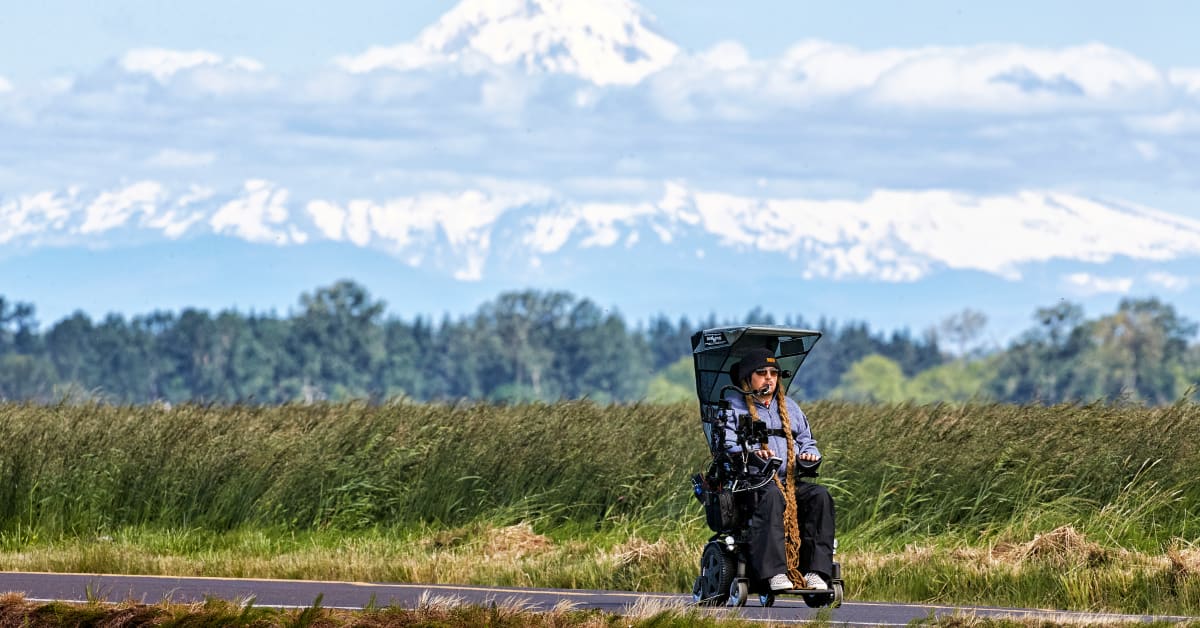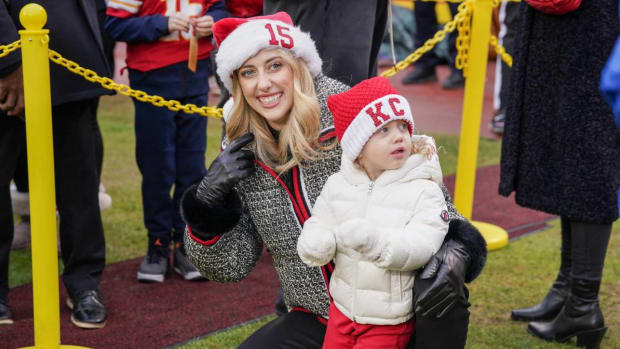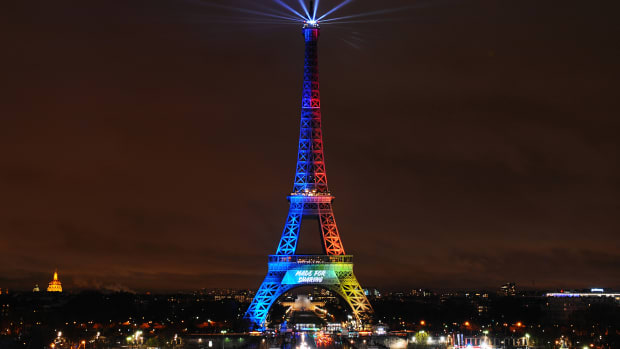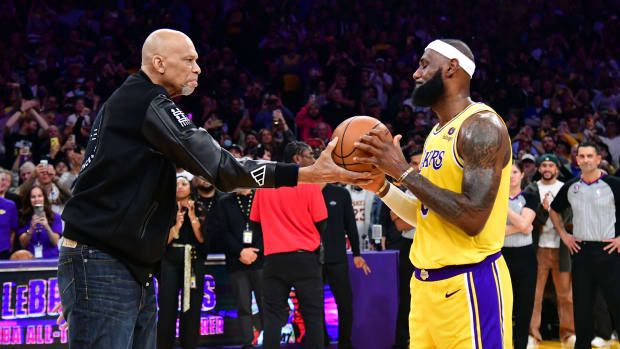Long into the year’s shortest night, muted light plays tricks on heavy eyes, and repetition can deceive a tired mind. Six times this group has completed the 12.29-mile counterclockwise loop: always south alongside the Willamette River, east past the pumpkin patch, north along the Columbia River before curling west near Sturgeon Lake and running south by the dairy farm and the cabbage patch, across the Gilbert River, and then, finally, back to base camp at the Sauvie Island Community Church parking lot.
By 4 a.m., the entire endeavor feels positively Sisyphean. Ian Mackay leads the procession, a small headlight secured to each side of his rig. For hours he’s been flanked by his girlfriend, one of his former professors and a rotating cavalcade of friends and family on wheels. Mackay’s father drives a trail car, dragging an arrow board, directing cars to pass on the left.
These riders form an unlikely constellation: educators, construction workers, salespeople and speech therapists wearing cycling jerseys, tutus and everything in between. They’ve been drawn to this island at the confluence of the Columbia and Willamette, just north of Portland, by the gravitational pull of a 40-year-old wearing checkered Vans and a gray beanie, with a goatee and floor-length dreadlocks that are now braided in pigtails to keep from dragging. Fourteen years ago a bicycle accident left Mackay in a wheelchair. Now he and his co-riders—Mackay in an Invacare TDX SP2, the rest on bikes—embarked on these loops at 8 p.m. on June 21, the summer solstice, and they plan to keep circling at 8.5 mph, the fastest Mackay’s ride can manage, until he sets the record for the greatest distance covered in 24 hours by a motorized wheelchair.
Mackay drives his sip-and-puff-powered chair with a straw that extends from above his right armrest: A hard puff starts him forward, a soft puff turns him to the right and a soft sip sends him left. On top of the challenge of executing these maneuvers while fatigued, Mackay can no longer regulate his body heat. If his temperature falls too far or climbs too high, it could be fatal. And then there’s the risk of spasms, sores or infections from the long ride. (Since his incident, he hasn’t sat for more than 12 consecutive hours.)
That, and there’s the mental grind of it all. Dawn approaches, and Mackay struggles to keep his eyes on the monotonous road. As Camus wrote: “One must imagine Sisyphus happy.” By now Mackay’s smile has faded. Still he rolls on.
As the sun seems to resist rising over the peak of Mount Hood, to the east, the resolve of those few people who’ve agreed to bike alongside Mackay for all 24 hours also begins to fade. In 2017, South Korea’s Chang-Hyun Choi, who is paralyzed from the neck down, covered an unprecedented 173.98 miles in one day, in a mouth-controlled motorized wheelchair. To top Choi, and to put his own name in the Guinness Book of World Records, Mackay knows he must keep moving. To complete his goal of 15 laps around the island, to break the record and then some, he’ll run up against that proverbial wall again and again. So, he defies that unceasing inner voice that says it’s time to stop.
The campus of UC Santa Cruz is nestled in the woods on Ben Lomond Mountain, overlooking the small Californian beach town. And where the tree cover opens, near the music center, there’s a steep route down, called the Great Meadow Bike Path.
On June 4, 2008, Mackay—then a 26-year-old undergrad who’d already been through two community colleges before landing at Santa Cruz—headed home from his job as an assistant at the school’s botany lab and started his descent. Each afternoon, on his commute, he kept an eye on his bike’s speedometer, hoping to set a new personal record. “Forty-two [mph] was the fastest I could ever go—but I wanted to go a little faster every time,” says Mackay, who would pedal over the lip and then go “full tuck,” his hands gripping the seat post, “banzai-ing down that hill.”
On this particular day, Mackay saw his readout hit 38 mph as he sped past a student housing cluster in the campus’s lower quarry—and then his front wheel skidded on a patch of sand, sending him headfirst over the handlebars, into a tree. On impact, his helmet cracked and his C3, C4 and C5 vertebrae fractured. “I remember the sand. I remember leaving the bike and going towards the tree,” Mackay says. “And then—it felt like seconds later—I remember lying underneath that tree, looking up and noticing I couldn’t move or feel much of my body.” A woman approached, and Mackay asked her to call an ambulance. EMTs arrived, put Mackay in a cervical collar and carted him to a helicopter that flew 30 miles to the Santa Clara Valley Medical Center.
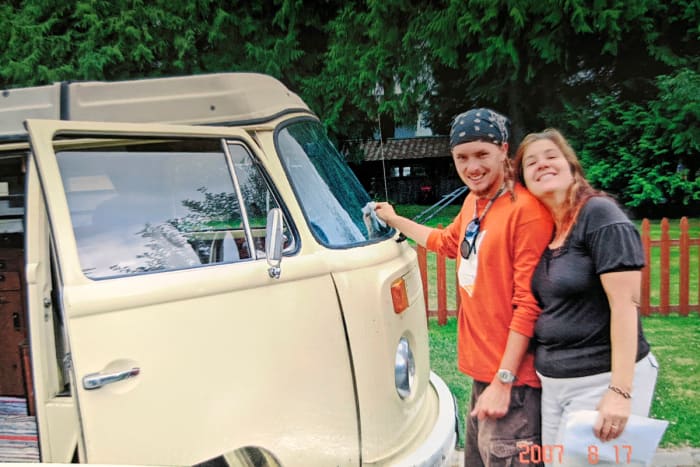
One year before his accident, Ian (with his mother, Teena) was chipping away at school, planning a career as a community college professor.
Courtesy of Ian Mackay
Mackay recalls lying in a hospital bed, staff repeatedly sticking him with a safety pin, starting just above his navel and slowly moving up his body to see when he felt the prick. When he did, they’d stop and draw a line across his skin. The first was on his chest, right below the nipples—but they repeated the process every 15 minutes, and each time the line moved higher. Mackay now understands that his spinal cord was swelling, pushing paralysis farther up his body. “We have to intubate you,” doctors told him, “because very soon your diaphragm will be paralyzed, and you’ll no longer be able to breathe.” Mackay closes his eyes as he returns to that day.
“It’s weird to say, but there was a peacefulness. A serenity,” he says. Why hadn’t panic or shock overtaken him? “It felt so out of [my] control that worry or concern or stress or anger just didn’t make sense at the time. It seemed big. It seemed significant. . . . But I knew on that day, I wasn’t going to be able to change anything.”
He wants to make this clear, however: That serenity didn’t last. “With the realization of things—dealing with nurses and doctors, the lack of sleep, the pain and the f------ change of losing everything,” Mackay says, tearing up—“that inner peace went away.”
With his first call from the hospital, Mackay asked his roommate to feed his dog. Then he rang his mother, Teena Woodward, in Santa Barbara, a four-hour drive away. “I’m pretty hurt,” he told her as a nurse held the phone to his ear. “You better get up here.” Teena, then 45, frantically filled a suitcase and left in a blur.
Arriving a bit before dawn, she walked into what she calls “the freakiest, most out-of-this-world” scene. The room was dark, lit sparingly by the colored lights of all the machines. Her son lay splayed out, in a gown, with a ventilator tube in his throat. With his arms and legs strapped down at 45-degree angles, he evoked the Vitruvian Man.
Teena ran from one side of him to the other and back. “Tears were rolling down his eyes. Tears were rolling down my eyes,” she says. Finally, she took a breath and composed herself. She understood then and there that her life was forever changed.
For the next three months, Teena spent every possible minute at her son’s side, sleeping in a chair beside his bed. For the subsequent 14 years, she’s been only a few steps away—or close enough to reach him with a phone call’s notice. “I never left,” she says.
Eventually that hospital room grew full, the air thick with frantic energy, love and sorrow. Waves of visitors—family, hippies, a poet, science professors from Santa Cruz—would roll in and out. All except one: Teena. She was always there, always locked on the eyes of her oldest son—“our only way to communicate,” she says, “with our eyes.” The boy she’d watched run and swim and bike could no longer move or breathe on his own. But he was still alive. Teena knew that more than anyone. More than Ian himself. She refused to look away.
Underneath a pop-up tent in the church parking lot, two timekeepers on folding chairs record the exact time each lap starts, and every hour they log Mackay’s mileage, radioed in from another rider. As the cavalcade turns the corner of Northwest Reeder Road and arrives at the church, the dark has paled into that sideways light of a rumored dawn. The biggest concern throughout the night, beyond Mackay dozing off and losing control, has been that his temperature might drop below 94°. Teena, waiting in the parking lot, has been heating tube socks full of rice in the church microwave, tucking them onto her son’s lap for warmth; and Mackay’s girlfriend, Celina Smith, long ago wrestled a fleece and a puffer jacket over his long-sleeve shirt. Earlier in the evening, his stepfather, Russ, tightened a seatbelt around Mackay while Teena took his temperature, which at the time registered 98°.
As Mackay completes his sixth lap, at 5:03 a.m., however, the thermometer shows 95.3°. In the church parking lot Teena tries to talk him into a 10-minute break; she has turned the heater all the way up in her white converted van and has the ramp down, ready for him to roll in. But Mackay, by now slightly punch-drunk, believes it’s beyond fixing. The cold is in his bones, he says, and he must power through. Teena, just as stubborn as her son, holds back tears of frustration and concern. Finally, she tells him, “Talk to Dr. B.”—Josh Blaustein, an old chemistry professor turned pal of Mackay’s, along for the ride—“and your crew, because I’m not getting through,” and she walks off.
Ian and Teena are strikingly close—“best friends,” as Teena’s mom, 81-year-old Bev Dawson, explains. After the crash, Ian came home with the physical capacities of a 6-month-old. That regressive state brought mother and son tighter than ever. It also returned to Teena something akin to that universal fear of a new parent. She had to retrain herself to trust that her son would be safe outside of her line of sight. And that took years.
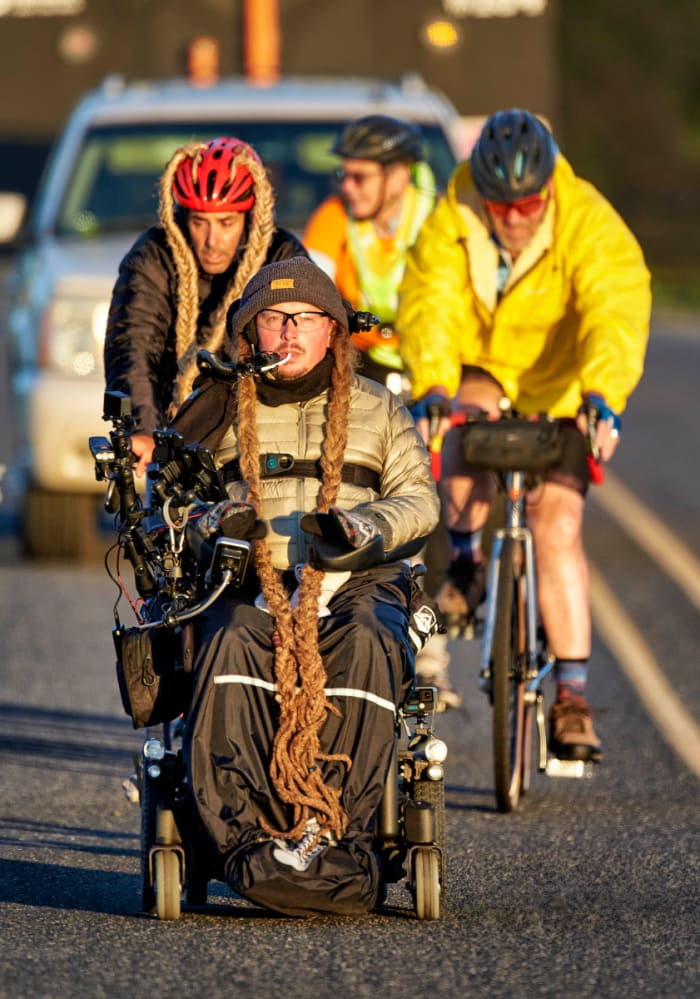
The goal for Ian and his wheeled friends: 15 times around a 12.29-mile course in 24 hours.
Jonathan Ferrey/Sports Illustrated
This morning, as her son’s temperature dangles on the edge of disaster, Mom ultimately gets her way. Smith and Blaustein convince Mackay to warm himself. “All right, I’ll take 10 minutes,” he says.
At 5:20, he rolls back out of the van, giving the weariest of smiles. The sun has crested past the mountains’ peaks as the riders set off, back down Northwest Reeder Road for a seventh time.
The first year after the crash was the worst of Mackay’s life. He’d been 12 months from finishing school, with plans to do research in the canopies of temperate forests before pursuing a career as a community college professor. The loss of that imagined future, along with his movement and his breath, was shattering. When Teena rushed to his side, she and Russ had just retired; most of their things were already boxed for a move to Port Angeles, Wash. After they all left the hospital, three months later, they went north, to that new home and a new life. Ian’s father, Zeke, quit his job in San Diego and came up with them, too. For the next five years, Teena, her husband, her son (sleeping in the adjacent room) and her ex (on a couch, or on a futon in Ian’s room) all lived together in a two-bedroom house in the woods.
Teena’s lasting image from those early days is of Ian sitting on the sofa in a robe or gown, buried beneath a blanket, illuminated by the light of the television, all of it soundtracked by the robotic beat of a ventilator—that vacuum inhale and then two thuds as the mechanical lung releases. For those first 12 months it was a chore to get a word out of Mackay. Doctors had implanted a breathing tube into his windpipe, and to speak was an uncomfortable ordeal: He had to deflate a cuff—a small balloon inside his throat that keeps air from escaping—then refill it with 7 ccs of water when he was done. Still, Teena knew it was more than just the cuff that kept him silent.
At the hospital, the mess of machines and nurses and visitors, and all the attendant planning, had kept the family in a fog. But now the solitude of rural Washington gave them the space to feel the weight of what they’d lost. “I remember talking about the fact that the grief was so bad, because it was as if he kept dying,” Teena says. “He was lost, and we just didn’t know where we were going.”
It didn’t help that Mackay was despondent and bitter. “I didn’t return the love I was being given,” he admits. “I was miserable.”
“A human being,” Sophocles wrote, “is only breath and shadow.” When Mackay’s breath deserted him, the only thing left had been a shadow. He’d spent his early 20s searching for a path, which he thought he’d finally found. He was confident and focused; everyone could see it. But then the crash dragged him home, into a haze of pain pills, grief and silence, his whole world reduced to a few rooms in the wilderness.
Finally, a year after the crash, a breakthrough: Rehabbing with an occupational therapist, Mackay thought he felt himself taking small breaths while working to raise his shoulders. One night, as a test, he asked Zeke to remove the ventilator and put a thumb over his throat, with the cuff deflated. When Mackay breathed on his own for more than a minute, “it gave me hope,” he says, and for the next month he experimented without the ventilator, until he no longer needed it during the day.
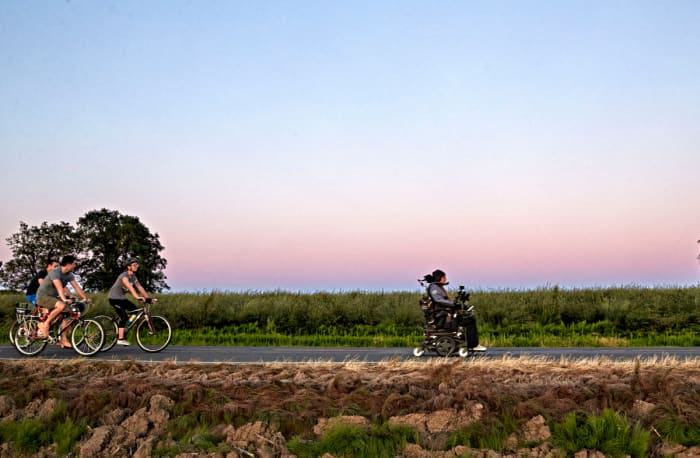
“A human being,” Sophocles wrote, “is only breath and shadow.” When MacKay’s breath deserted him, the only thing left had been a shadow.
Jonathan Ferrey/Sports Illustrated
Doctors couldn’t explain it; it was and remains the only real gain Mackay has made since his injury. But once he got off the ventilator, his voice returned, and Teena could see the son she knew returning, too. During the voiceless year he would click his tongue to get Teena’s attention. “But now he’d yell, ‘Mom!’ and it was the most beautiful thing to hear,” she says. “When he started to talk, he started to come back to being Ian.”
As the fall of 2009 arrived, she noticed her son begin to turn from the TV to the living room’s tall windows. Mackay asked his parents to put a feeder on the sill, and he started to bird-watch—“that’s a dark-eyed junco . . . that’s a spotted towhee”—as he had in the days before his crash. Teena bought a copy of The Sibley Guide to Birds, and they worked together to identify every bird on their five acres. Now, Ian kept one eye on the world outside.
Before Apple introduced Siri, in 2010, with its voice- and gesture-based controls, the biggest challenge for a quadriplegic, typically, was a simple one: how to press a button. Teena remembers her son’s first stab at this, and how he practiced to perfection with a small headset that attached to a BlackBerry and allowed him to make a call with his sip-and-puff straw. And then: “His first adventure was to his grandparents’ house, across the street,” Teena says. “I called my mom three times to see if he was there yet. I was so, so worried.”
Teena was still nearby, but that third-of-a-mile journey was a revelation. Her son could leave home alone again.
Mackay began exploring, and in turn he started to rediscover himself. He used a durable chair right out of rehab, and now he tested its limits as he ventured farther and farther down the 135-mile Olympic Discovery Trail that runs alongside his family’s property. Teena would get calls that his battery had run out or that he’d tipped over or that his leg bag was full—but then she’d come find him, and he’d get back on his way again.
Blaustein, now 52, remembers how in the years before the crash his friend was so drawn to the outdoors and to adventure that he would often suffer from exposure to poison oak. They’d be hiking, and he’d see a plant off the trail and just dart toward it. Later, Blaustein would make the trip north to visit his friend whenever he could, and in that dark, silent living room he wondered how Mackay would ever find purpose again after being robbed of the means to explore.
Now, though, with Teena’s help, the two friends could traverse the trails around the Mackay property. And it became clear that in doing so Ian could begin to heal the emotional scars of the crash.
Soon enough, he had covered the entirety of the Olympic Discovery Trail. “He [rode] the length of it, and then he said, ‘Let’s do the whole state of Washington,’ ” Teena says, grinning. “I’m like, ‘You’re out of your mind.’ But he said, ‘No, let’s do it.’ And so we did.”
The sun sits just above the horizon, and a belt of clouds covers the mountains in the distance. An old pickup truck, overflowing with cabbage, rolls onto the two-lane road. Traffic peaked right after sunset, but the rest of the night remained quiet. Now, Mackay’s headlights shine around a corner, followed by Smith, Blaustein and a couple of other riders.
At 8:26 a.m., more than halfway into the ride, a skeleton crew pulls into the church lot, and the timekeeper asks the distance: 98.5 miles. Russ rushes over with a backup lithium wheelchair battery on a dolly and helps switch it in. Teena feeds her son a banana and a pill to limit his spasms. She takes his temperature and is elated to see it’s back up to 96.7°. For the first time, everyone allows themselves to believe Mackay might just finish.
Among the believers: Kenny Salvini, who arrives at the lot later in the morning with his wife and toddler. In 2004, Salvini was 23 and had just wrapped up a wrestling career at Central Washington when he broke his neck in a skiing incident that left him paralyzed from the neck down. For the next seven years he was a shut-in, spending half that time in bed battling sores.
“It’s a deep, dark hole,” he says. “You wake up wherever you wake up, and you’re looking at your arms and your feet that are no longer connected to your body, and it’s as close to a mental, emotional and spiritual crisis as there can be. I really had to mourn the guy that I was.”
Mackay met Salvini (“The Hot Quad,” as Smith insists he’s nicknamed) at a barbecue in 2012, on the anniversary of a mutual friend’s injury. Now, says his grandmother, “they’re like a couple of teenage girls. They’re on the phone all the time! They giggle!”
As a young man obsessed with all things kinetic—skiing, wrestling, wakeboarding—Salvini says he believed the mind and body were inextricably linked. But he’s since come to understand they’re distinct. “It’s so hard to wrap your head around [the idea] that there might be something else to it,” he says. “It’s a testament to the human spirit that you can go through so much and still find a way. That life still tries to find a way.”
Mackay remembers the beginning of his own struggle. That first week in the hospital, a friend played him a song by the late folk singer Guy Clark, “The Cape,” about a kid who leaps from his garage with a flour sack knotted around his neck, believing he can fly. He hits the ground but then keeps on leaping, over and over, until he’s old and gray. Spread your arms and hold your breath / Always trust your cape. It was too early for Mackay to take the lesson to heart, but the words lodged their way into his head.
Rediscovering your old self, Salvini explains, starts with finding that one thing that gets you out of the hole and fires you up again. You need to locate the why. For Salvini, it was people; he started going to support groups for quads, and it felt like he was on a team again. For Mackay, it was those daily rides down the Olympic Discovery Trail. Then, it was more.
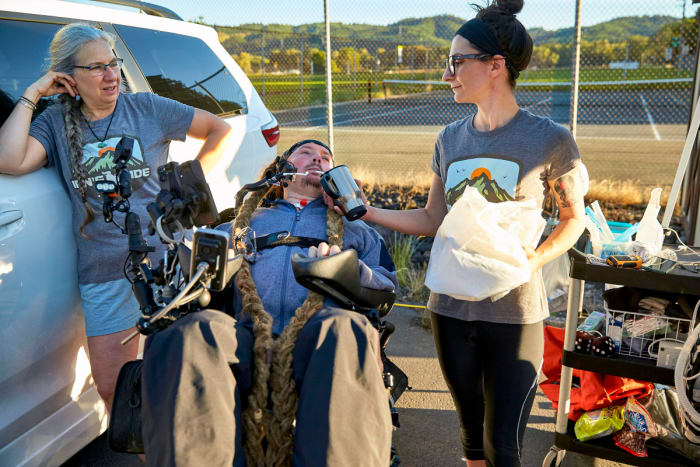
Teena (left) and Celina kept Ian’s tank full at the starting line.
Jonathan Ferrey/Sports Illustrated
Josh Blaustein was instantly taken with the energy and magnetism of the dreadlocked student who walked into his chemistry classroom at Cabrillo Community College, near Santa Cruz, 18 years ago. The two became fast friends, attending concerts and going on hikes. Blaustein invited Mackay over for dinner, and he still remembers how effortlessly this student got his two young daughters excited about the natural world—birds and plants and so on.
In 2006, two years before the crash, Blaustein invited Mackay to drive the support van on a bike tour that he and some buddies were taking across Northern California. A year later, Mackay drove along again as the group traversed British Columbia. Mackay, who was just then getting serious about bicycling himself, says he loved those experiences—but quietly he wished that he, too, was on a bike, instead of in the van.
Later, in the first few years after his crash, Mackay hardly thought about that time on the road with his friend. But then Blaustein began to use the Port Angeles property as a sort of base camp for further tours of the northwest, and hearing stories from those trips rekindled in Mackay that bit of longing. “There was envy when I was in my chair,” he says, “and they were heading off on this adventure.”
Finally, in 2016, Mackay rang Blaustein and made a pitch: a 10-day, 335-mile bike-and-wheelchair tour from B.C. to Portland. Blaustein was in without a second thought, and that August they took a ferry north before setting off, staying along the way with friends that Mackay had met through quad support groups. (“Somehow, [Ian] planned it so every day ended at a brewery,” Blaustein says with a laugh.)
In 2018 they hit the road again, riding the 476 miles from Coeur d’Alene, Idaho, back to Port Angeles in 13 days. They climbed the Cascades and battled the heat of eastern Washington. Two years later, they took on a 272-mile route from Brookings, Ore., to Fort Bragg, Calif., over the course of one week, keeping the same max speed of 8.5 mph, up and down hills. As Mackay wrote on the blog for his nonprofit foundation, Ian’s Ride: “This wheelchair is my bike. I am of the firm belief that more people, not just the mobility-challenged, should get outside and pursue a passion.”
Much can go wrong on the road—especially for Mackay, even with his mom always trailing in a support van. Those rides are “hard, and they’re beautiful, and they’re draining and they’re hysterical,” Teena says through tears. Mackay wears layer upon layer to keep his body temperature up when it’s cold out. More dangerous, though, is the heat; Mackay’s temperature needs to stay below 102°. (To combat this, he rides with a shade canopy. And ice packs on his groin or under his armpits can usually bring his temp down.) Mackay can’t feel pain—the signal gets deflected back to the source when it reaches his spinal lesion, before being sent again. This rapid pinging increases his blood pressure, and a headache or a hot flash is his clue that something is wrong somewhere in his body. “You have to become a detective and start figuring it out,” he says.

Sixteen years after Mackay (third from left) drove a support van for Blaustein, he led a new kind of ride.
Courtesy of Ian Mackay
Then there are the physical obstacles beyond his body. Rumble strips. Pouring rain. Logging trucks. Mackay recounts one ride on which he hit a rock on a narrow shoulder as he and Blaustein crossed a bridge, sending his chair into traffic. “Now I’m on the freeway, and there’s this giant truck coming and hearing that truck swerving. F---, talk about adrenaline,” Mackay says.
With all this risk, what is Mackay chasing on these adventures? “I didn’t get to experience [the rides] before I was injured—but I sure as hell have now,” he says. “Getting to actually live that experience I wanted so bad, and to do it in this unusual, quirky way—it’s freaking awesome, man.”
There’s a lesson here that Mackay always shares with fellow quads: In the struggle to recover what is lost, we often forget to keep pursuing what we never had in the first place. It took him a while to learn this, but he knows it’s been essential in finding himself again. “So many of us try to redefine who we are, but I think happiness lies in embracing the loves you always had and finding ways to do them in a different way,” he says. “I don’t think that your limitations should define what you love and what you pursue.”
It’s almost 5 p.m. when I ride up beside Mackay. He’s been on the same loop for 21 hours. He hasn’t slept, and his hands have turned maroon from the sun. He’s consumed just that banana, a few bites of an apple, a bit of a burrito and enough Ensures to unsettle his stomach. He says he never really sleeps much, but he’s tired now in a way that feels novel. Still, he knows: Two more laps and the record is his.
Mackay tells me of the uncanny feeling of transforming in an instant from an active 26-year-old to a man with the bodily functions of an infant. He was depressed, but he was angry, too. He’d been a year from graduation, ready to go “full tuck” down his own path, and then he went over the handlebars and he was back at home again. He felt cheated.
“There was so much anger, so much sadness, and I felt so much loss that I didn’t want to talk,” he says. “I [feared that] I would shout out at those who loved me the most, so it was safer not to speak.” (Russ remembers it well: “He was a d--k, an a--hole. But you got to understand where he was coming from. He was pissed off.”)
As we pass by the Sauvie Island Kennel, I ask Mackay how long it took to get back to where he’d been. He says it was a friend, Todd Stabelfeldt, whom he calls The Quad Father, who showed him he could keep on living after this kind of injury. It was Salvini, the type of guy he would’ve befriended even before his fall, who made him start to feel like his own man again. And it was Smith, a speech-language pathologist he met through her job, who has allowed him to imagine getting old. (After their first date three years ago, at the Space Needle, Ian and Celina now spend every weekend together, and she says: “When we’re together, there aren’t bad days. He is my medicine, in a way.”)
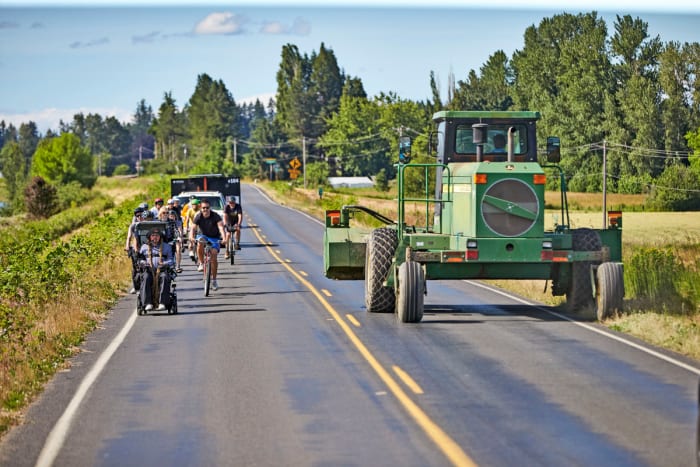
Mackay’s main impediments, on and off Sauvie Island: tiredness at night, his own fluctuating temperature … and traffic.
Jonathan Ferrey/Sports Illustrated
Among ultrarunners and off-road racers there’s a strong sense that the physical is less than half the battle in a daylong race. It’s more about going full speed into your mental wall and breaking through, and then being resolute, even while knowing another wall is waiting, right down the road. The best are rarely the fastest, the strongest or the most technically skilled; often, they’re just people unlucky enough to know real pain, which puts a race into context. At a certain distance, grit is the great differentiator. At a certain distance, talent is superseded by the ability to just go on.
Mount Hood peeks above the horizon to our left as Mackay tells me he’s been repeating the phrase “embrace the misery.” It’s a mantra that any runner, cyclist or gym rat can relate to. But for Mackay, misery is a realized state. It goes beyond a bit of pain. He tells me he’s too tired to keep talking about himself. He asks about my parents, my brothers, my dog. He asks about my due date, and I think he means for this story—but in fact he’s remembered that my wife at home is pregnant. As we’ve been speaking, he’s been wincing, but now that smile reappears. Could Sisyphus be happy? Mackay rolls on, at 8.5 mph, back toward the church parking lot.
Lap 14 ends, and Mackay is two miles from his goal, but the Guinness bylaws are vaguely written, so everyone agrees he must complete a 15th lap to break the record. Mackay sets off again a bit after 6 p.m., with the biggest crew yet—“his tribe,” as Salvini puts it—riding by his side, and they all roll along Sauvie Island Road while the low light slides off the Willamette.
As they approach the Sauvie Island Bridge, Smith and Blaustein ride up alongside Mackay, each putting a hand on his canopy. Zeke slaloms through the crowd of bikes on a Onewheel electric longboard and raises his hands. Everyone lets out a scream as Mackay’s Strava ticks past 173.98 miles. Everyone except Teena. She’s biking along now, in the middle of the pack, awestruck, trying and failing to stop the tears.
There are still 10 miles to go before the parking lot, but time is no longer a concern. Each lap has taken less than an hour and a half; Mackay just needs to finish this one in under two. Finally, at 7:30, he pulls in, greeted by a cheering crowd and cameramen from local news outlets and a documentary crew filming his feat.
Off to one side, Teena, Russ and Zeke observe Ian in wonder. Zeke asks, “Are we crazy?” Teena and her ex tear up and shake their heads.
A few days later, I text Mackay to see how he’s feeling. “There’s a wide mix,” he writes. “Reflective, intense, amazed, grateful, loved, exhausted and strong.”
So what is Ian Mackay chasing?
He’s open about his injury, his recovery, his relationships and his fears. He doesn’t balk when detailing the day-to-day realities of his life, like needing someone to clean him and turn him in his sleep, to avoid bedsores, or the emotional hurdles of Smith being both his caregiver and his lover. He’s introspective and relentlessly forthcoming. Still, he can’t quite explain what drew him to risk his health for a record that no one, including himself, had ever thought about before he looked it up on a whim four years ago. Is he trying to prove how far he’s come since escaping that dark room? Is he crafting an emblem of his independence? Or is it that intangible itch that all athletes need to scratch? His friends and family hem and haw at this question, crediting a desire to push himself, or maybe an innate need to explore. Some admit they’ve never thought much about it. When I ask Teena, she says I really should talk to Salvini.
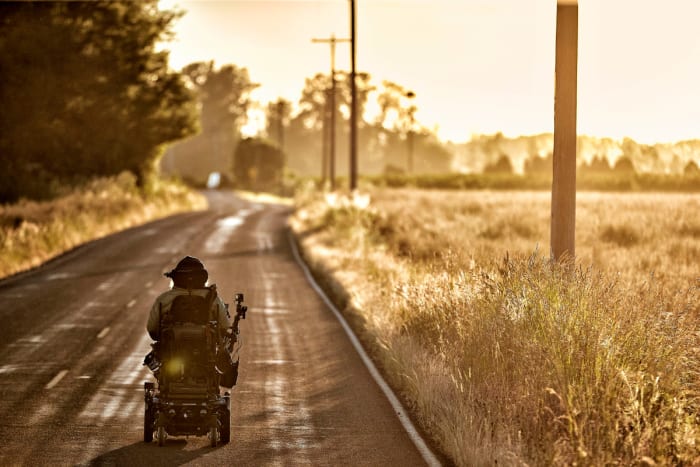
Mackay, in his quest, repeated the phrase “embrace the misery,” which for him is a realized state.
Jonathan Ferrey/Sports Illustrated
Under the shade of an RV canopy, The Hot Quad tells me it’s the same thing that made his friend put his hands behind his back to get that extra mile per hour down the hill on the Great Meadow Bike Path. “I’ve always joked that we don’t get into [our condition] by making good decisions,” he says. “Sometimes that doesn’t change.”
Salvini tells a story. It’s 2014, the 10th anniversary of his crash, and he wants to ski down the fateful mountain to mark the day. So he gets to the top, and friends put him in a seated rig, tethered to another skier who’ll act as his brakes.
“Well, my brake guy loses a ski and we rag-doll down the hill,” Salvini says. “I’ve got on a GoPro, facing me, and [on the video] I look like one of those blow-ups at the car dealership with their arms flailing. For a second, I’m like, Am I gonna get airlifted off this mountain again? But they picked me up, righted the ship, and it was like, Yeah, I’m not as fragile as I thought I was.”
Recovery means regaining possession of something lost. But Mackay is past that; he’s capturing something he didn’t have before. So I try again, a bit differently: Are we all on Sauvie Island because Ian Mackay wants the world to see his place beyond recovery?
Salvini takes a moment.
“There’s a quote: Life begins at the end of your comfort zones. [Ian] is most definitely proving that,” he says. “We need those reminders, that maybe our mind is the only thing that’s limiting us. Maybe it’s not just our bodies.”
To learn more about Mackay’s nonprofit foundation, visit Iansride.com
• Shawn Bradley, Paralyzed in a Bike Crash, Knows ‘It’ll Never Be the Same’
• LeBron Explains His Grand Plan
• Gabriel Taylor Is the Late Sean Taylor’s Brother—and Maybe His Successor
• She Kicked for Vanderbilt, and Then Things Got Hard
